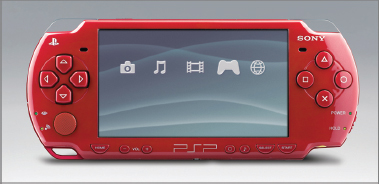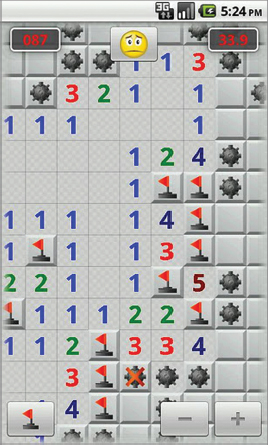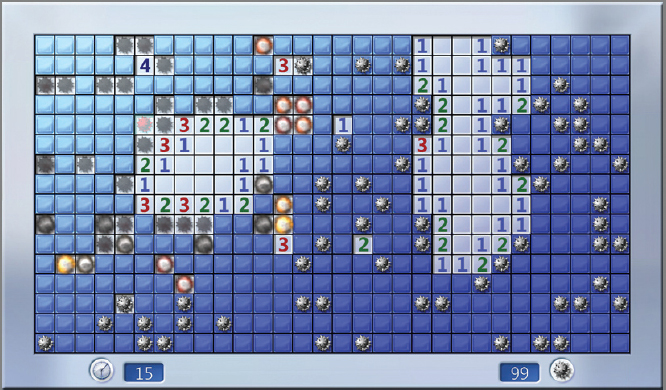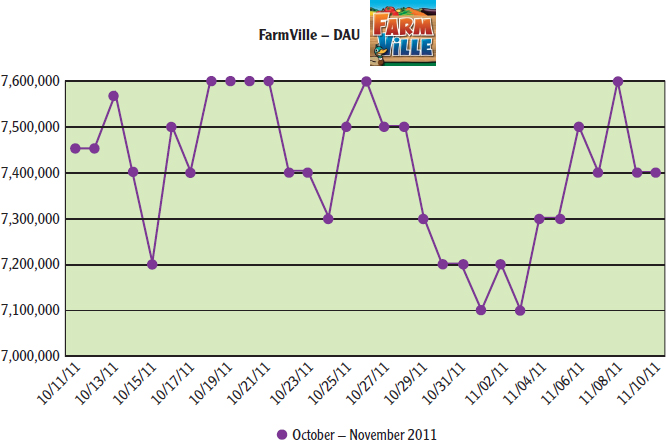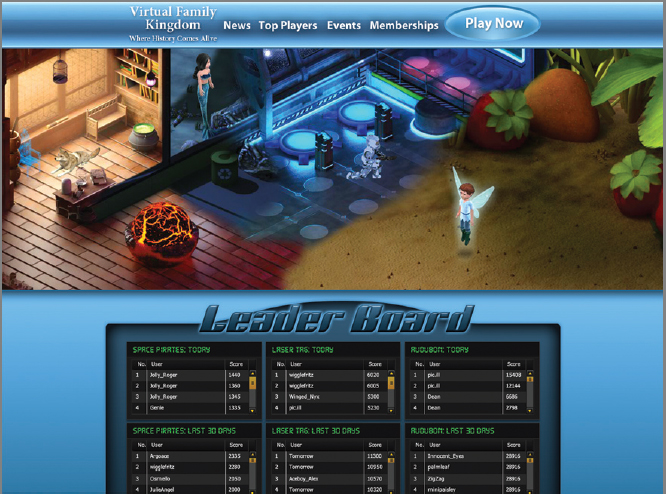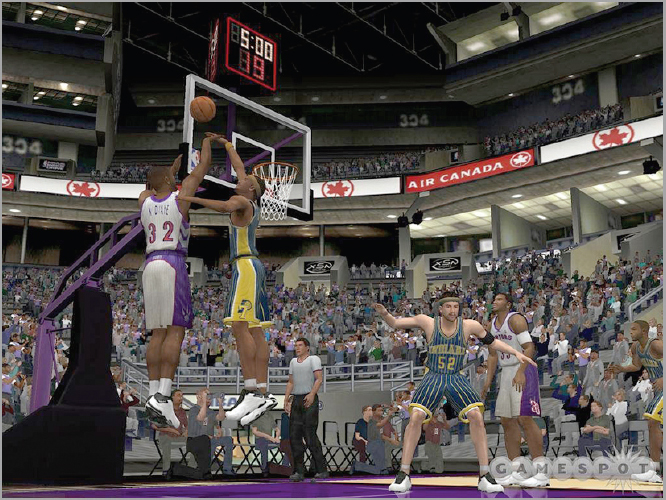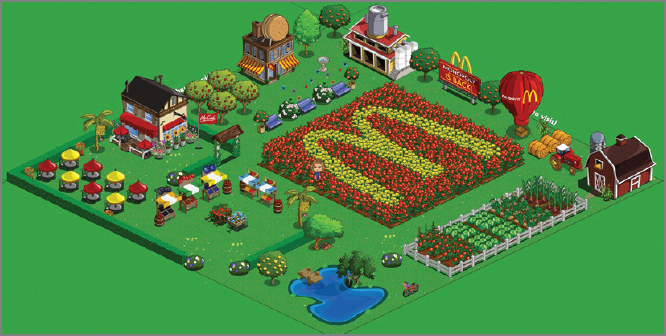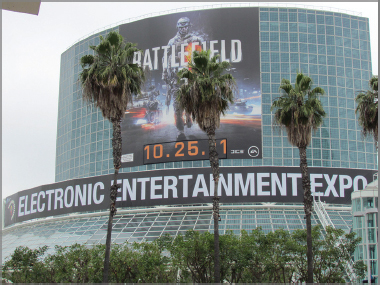CHAPTER 10
Distribution and Marketing
Distribution for games has expanded from the early forms of arcades to home computer systems to extremely successful console systems. Games run on numerous platforms.
Add to that the ever-increasing handheld markets, with laptops that have extensive battery life (great for long flights) and higher-powered cell phones that play hundreds of games with better, faster graphics and larger display screens, and the gaming industry currently has many different platforms for which to create games.
Gaming has grown so dramatically, surpassing even the sales of feature films, that marketing for them has also increased. Not only do the manufacturers of games recognize the massive revenue coming in from sales, but advertisers have also embraced this medium as a genuine avenue for advertising other products.
Clever marketing people have looked at all the methods people can use to access and play games. They have explored and exploited numerous schemes for getting their products in front of consumers, both to sell the games themselves and to use them to help market other products. As technology continues to provide more methods for distributing games, advertising is expected to keep pace with that growth.
- Platforms
- Online
- Using games for marketing
- Marketing of games
Platforms
In a nutshell, a platform is the electronic system used to play a game. Home computers like the Mac and PC are platforms, and dedicated consoles like the Wii and Xbox are platforms that play games. There are numerous online avenues and, of course, the expanding markets for mobile and handheld devices.
Many game companies build their games for more than one platform, to capitalize on the different markets available for sales and reaching their demographic.
The following is a list of some of the more common platforms used for playing games:
- PC
- Console
- Handheld
- Mobile
- Arcade
Games created for many platforms can be played online. We'll talk about online games after we look at these common platforms.
PC
Pc short for personal computer, is generally accepted as the term for any home computer system, whether it's a Mac or Windows.
Games that are distributed for the PC market indicate in their specs whether they're playable on the Mac and/or Windows. Crossing platforms (being able to have software work on either Windows or the Mac OS) is becoming more common; however, fewer games are built for or retooled for use on the Mac, simply because more gamers own PCs (Windows). Also, most development systems for consoles, handhelds, and mobile systems are Windows-based.
Games for the PC market can be downloaded directly onto the computer, played online, or installed using a CD or DVD.
The biggest challenge in PC development is piracy. That's the main reason most companies cite when discussing why they aren't developing games for the PC, and also why casual games are turning more to ad-based and micro-transaction/social games.
Micro-Transactions
A micro-transaction occurs when a player buys, with actual real-world currency, some type of in-game bonus. These can be special items like new potions or spells. This type of business model can be lucrative for game makers. These transactions tend to be quite small—about a dollar or so (hence the term microtransaction); but if a game is popular (even a few thousand players), the microtransactions can add up. They give players access to new, fun items that add to the gameplay but don't cost a great deal of money to buy.
The downside is that some players feel nickel-and-dimed, so game makers need to choose wisely about introducing micro-transactions into their games. Otherwise, they may turn players away.
An excellent example of how this approach to marketing and making a profit through micro-transactions works can be seen with the company Zynga, which makes FarmVille. Yes, Zynga has ads associated with the game; however, the company generates the majority of its revenue by selling virtual goods to players (seeds, livestock, and so on). Players use those virtual goods as currency in the game when they play with each other. Zynga has earned over a billion dollars using this system.
Property Rights Issues
Another issue is the debate over intellectual freedom versus intellectual property rights, especially where the Internet is concerned. Copyright, which was designed to protect intellectual property, can sometimes interfere with free speech. Game makers that post their games online can acquire a copyright. Others may play a game and build one very similar to it, and that is legal.
Development for the Home Computer Market
It's worth noting that the speed at which faster computers come out has made developers lazy. Twenty years ago, developers spent a lot of development time optimizing the product's code and resources to make it run as efficiently as possible on the computers available at the time. That is hardly a concern anymore, except for the most high-end games. Many developers would rather give up the portion of the market that doesn't have the newest high-end computers than spend additional development time optimizing their products.
Similar changes have happened with file sizes. The best resource-compression routines were developed during the time of the floppy disk. Work of that type slacked off following the advent of CDs. Eventually we started running out of room on CDs, and online digital delivery became more popular, so compression has become more interesting again; but part of the response has been to increase bandwidth rather than improve compression routines.
Performance-wise, PC development depends on the minimum or recommended system requirements needed to run the game. Or, another way to say this is that PC development depends on the minimum system requirements you feel will run the game without taking away from the gameplay experience. For most indie developers, it's not an issue, because they aren't doing super-high-end graphics; a basic machine these days will run their games fine. For bigger companies, generally, a cross-platform game made to run on Xbox/PlayStation will run on a PC without much trouble; you just have to improve the interface to work with a keyboard and mouse (although several don't—the game makers just let the PC gamers complain about the poor controls).
GAME-MAKING SOFTWARE PACKAGES
For those interested in creating a game for the PC, a number of software packages are available, such as GameMaker, which has versions for Windows, Mac, and HTML (www.yoyogames.com/make). Programs like GameMaker allow new designers the freedom to use drag-and-drop features to build their games without needing to write complicated code.
GameMaker is for creating 3D games. To experiment with making a 2D game, Game Editor(www.game-editor.com/Main_Page) is an open-source, cross-platform game creator that lets the user create their own games, not only for the Mac and the PC but for mobile applications as well. If you visit the site, there are sample games that users of the program have created.
It is a good idea to play the games made with these packages to get an idea of what can be accomplished with graphics, sound, and animation and to see how the gameplay works.
Other packages to look at include these:
MUGEN Makes 2D fight games
RPG Toolkit; RPG 95, 2000, 2003, and XP; Hephaestus
Make role-playing games
Adventure Game Studios (AGS) Free software that can be downloaded and used. Users need to have some knowledge of coding
The program Flash is also used extensively by novice/amateur game makers. Professionals also regularly use this more complex system to create not only graphics but also animation and coding.
There are plenty of online sites that offer tutorials on how Flash-based games are made, including the following:
There are thousands of Flash-based games that have been made and successfully marketed. Flash is an excellent program for the first time game maker in that you can make an entire game with just one to three people. The production time for these can be short, especially if you work through some of the tutorials found on the websites listed in this section.
Projects made using Flash can be played on PCs, along with web, mobile, and handheld systems. Flash creates 2D games. If 3D development holds your interest as a first-time game maker or indie developer, Unity may be the package you will want to explore.
Unity
Unity is another terrific development tool to look at which is quite popular with developers for the home computer market. Games made with Unity are also playable on mobile devices, the web, and social gaming. Downloading the software is free from their official site: www.unity3d.com.
One of the nice features of this package is that you can publish the 3D content made with this software to the web with the Adobe Flash Player. When you visit the site, pay special attention the “gallery” location because you can view trailers of products made with Unity and play several demos.
Playing the demos, again, is an important step in understanding the abilities of the engine, the creativity involved, and how well the gameplay works. You can also download demo projects that come with content that you can create games with.
At the site Activetuts+ (http://www.unitymagic.com/shop/en/unity-tutorials/ and http://www.digitaltutors.com/training/unity-tutorials) you can find more examples of projects made with Unity and work through some good tutorials on creating games with this software.
Consoles
The first successful console to use cartridges that plugged in new games was the Atari 2600. Released in 1977, it has a library of nine games.
Console systems are a huge aspect of the gaming industry. A great deal of money has been spent designing and building them, and substantial dollars have been invested in creating games specific to them.
Examples of console systems include the following:
- Microsoft Xbox
- Sony PlayStation
- Nintendo Wii
- Nintendo GameCube
- Sega Genesis
These systems generally attach directly to a TV monitor or a computer monitor or have their own projection systems. Every console has a microprocessor, a graphics system, and a controller. The controller is specific to the design of the console and allows the player to interact with the game.
The Wii (Wireless Interactive Interface), originally called Revolution, has a unique controller that is motion-sensitive. As the gamer moves the controller, they're able to mimic movements such as casting a fishing pole, wielding a drumstick, and even slapping with a flyswatter.
The controller is extremely fast and accurate, and it allows gamers to enjoy interacting with the game and mimic the movements needed to play. For example, in a sword-fighting game, players lunge and twist with the controller as if it were a blade, and enjoy some astounding gameplay results.
Figure 10.1 is an image of a Wii controller. These units are small, lightweight, and extremely easy to operate, which is essential, especially when the gameplay is fast-paced.
FIGURE 10.1 This handheld controller for the Nintendo Wii features a wing shape that is ergonomically designed for ease in holding the unit and operating the buttons with fingers and thumbs.
Other controllers, like the wing-shaped one for the Sony PlayStation, are designed to be held comfortably in the hands. The PlayStation controller has 14 buttons that the player can customize. There are also controllers that use joysticks, trackballs, footpads, and paddles, among other devices.
Handheld
Mobile phones can fall into the handheld category, but they're better classified as mobile platforms (discussed next).
This section focuses on handheld devices designed specifically for gaming, such as the Game Boy.
Games for handheld devices may come preloaded or can be installed by inserting cartridges or accessing the Web.
The Nintendo DS and Sony PlayStation Portable (PSP) are excellent examples of handheld devices. These devices can play all of the gameplay styles discussed in this book, including adventure, arcade, board and card games, sports-related games, RPGs, and strategy. Not only are all gameplay types represented on handheld games, but the variety of games available is extensive.
The first handheld game was Auto Race, released by Mattel. The first to use interchangeable cartridges was Milton Bradley's MicroVision.
Figure 10.2 shows the Sony PSP portable handheld unit that can be purchased with Sony's game God of War already loaded. The unit has a portable charger, so it can be powered up from any outlet. It also comes loaded with what is known as firmware. Firmware and software are similar; the only difference is that firmware(which is a combination of software and hardware, also referred to as the system software) is the term used for software that comes preloaded onto a device and has been written onto read-only memory (ROM).
FIGURE 10.2 PSP units are highly portable, lightweight, and durable. The version shown here is the Deep Red unit.
These units can connect wirelessly to the Internet, and in addition to games, they're able to play movies (in the MP4 or AVI format) and music and display images.
Handheld devices appeal to people who travel a great deal or who simply like their portability. Handhelds (and mobile devices) also appeal to consumers because of the other features they come with, such as the ability to access email, online conferencing, Internet access, and many applications that let users manage their calendars.
As on mobile devices, the screens are somewhat small, so game makers need to handle real estate carefully by using simple graphics and large type.
Mobile
Smartphones, such as the iPhone, Android, and Blackberry, are great examples of mobile devices. They're usually equipped to access the Internet, so online play is available; and many mobiles have games installed on them when purchased.
Mobile devices are approaching the functionality of laptops. Most fall under the overarching term mobile Internet device (MID). Some of the companies that create these are Acer, Asus, Casio, Dell, E-TEN, Fujitsu, and Group Sense PDA.
The amount of space that is visible in any game (what you see on the monitor) is referred to as real estate.
Some games are made specifically for these mobile devices (as you saw in Chapter 2, “Gameplay Styles,” with the work Mobile Pie does); however, adapting games to mobile devices has been a challenge for designers because of the tiny amount of real estate available.
Designers have to find a way to set up the unit so a gamer can interface comfortably with the game. Initially, games for mobile phones were fairly low-end in terms of graphics, animation, and speed of gameplay, simply because the phones didn't have the computing power to run anything else. Minesweeper, shown in Figure 10.3, was one of the popular earlier games these mobile devices could play.
FIGURE 10.3 Early versions of Minesweeper were quite simple visually.
Figure 10.4 shows the look of a newer version of Minesweeper.
FIGURE 10.4 Along with improved graphics, this modern, revamped version of Minesweeper includes special-effects animation and audio that run when the mines explode.
As computing power increased along with the quality and speed of graphic displays, applications for improved phones were in demand. Flash-based games were a popular method for providing games for this increasing market.
The interface uses the touchpad on the phone. The Android HTC Desire smartphone has added to that interaction by providing a slight buzzing sensation as the player uses the touchpad interface, thereby giving the player more of a feeling of being involved with the game.
Critics of the games being designed for mobile applications feel that the products being offered are too repetitive and lazy in their design. As mobile device designs continue to improve, with lightweight cases, larger full-color displays, and faster computer speed, the challenge for game makers will be to come up with gameplay that is more challenging and compelling.
Arcade
Coin-op game is another term for arcade games.
Arcade games saw their golden era in the 1970s and 1980s with great games such as Galaga, Asteroids, Defender, and Centipede.
Many game aficionados actively seek out, purchase, and renovate older arcade games. They play them, too!
Many arcade games today are redemption games. These types of games are often found in restaurants that cater to young children, such as Chuck E. Cheese's. A good example of a redemption game is the claw type. The player inserts money and then operates a mini-claw that looks like a tiny construction crane, trying to pick up a toy inside a closed glass box.
There are modern arcade games that are highly popular, and what sets them apart from games played in the home are their elaborate controllers. Rhythm games, for example, have footpads for the gamer to dance on; the focus of these games is not so much the story or the gameplay, but the performance of the gamer using the device. This aspect allows these types of games to thrive in arcades, which are, ostensibly, social environs.
Online
Online gaming is one of the areas that has shown the most growth and diversity, which makes sense, given the increase in broadband use by consumers. Even users in remote areas that don't have access to cable systems for highspeed Internet can subscribe to online services through a satellite hookup (HughesNet is a good example). Online can be considered a subset of the PC, console, handheld, and mobile platforms, because any of those platforms can access games using this route.
Online games fall into three basic categories:
- Massively multiplayer online games (MMOGs)
- Social games
- Portals
MMOGs
The leading contender in this category is Blizzard's World of Warcraft (WoW), with millions of subscribers and billions in earned revenue. This game can be downloaded for free. After playing the free trial offer, gamers pay an initial cost plus a monthly subscription fee to continue playing.
The majority of MMOGs have the same type of business model: the initial game is free to download and play for a short time; then, if the gamer wants the full version, they're given an access code to unlock the rest of the game after making payment.
Some companies provide what is known as a demo version to play. Because these are such massive games, downloading a full version just to try it for a short time is prohibitive; therefore, many companies offer a pared-down version that provides enough of the actual gameplay experience to let the potential gamer decide whether they want to buy the full version without taking a huge amount of time to download or using up an inordinate amount of computer space.
There are several varieties of these massive online games, including MMORPG (role-playing games), MMOFPS (first-person shooters), and strategy and racing games, among others.
MMOGs tend to be highly social, and players interact with others a great deal. Because most of these games include a social feature that lets players talk to each other in-game, not all games are appropriate for all ages. WoW provides a language filter that essentially bleeps out foul language, and the company tries to be sure players don't select offensive names; however, the game isn't monitored closely enough for very young players. Club Penguin, currently owned by the Disney Corporation, is a MMORPG designed for children. In this virtual world, gamers assume the role of a penguin and live in a small town filled with igloos and other penguins. The game is highly social and filled with all sorts of mini-games. It has numerous safety features in place, so younger gamers can interact in a virtual community that is highly monitored for foul language, inappropriate comments, and so on.
As we have discussed previously in this book, when a game designer begins to work on a new project, special consideration needs to be given to the target audience—the demographic. In the case of online social games, players are likely to encounter other people; therefore, your demographic becomes part of the gameplay. Predators seek out these social forums to prey on young people or try to bilk other players out of their money and gather personal information with scams of all types, especially spy software like keylogging programs. Hackers use programs such as keyloggers to infiltrate users' computers and monitor what they're typing (like passwords), along with sites they may be visiting (such as an online bank).
Designers of MMOGs need to provide strongly written disclaimers for their games and build in filters to prevent predators from accessing personal information or targeting other players in the game. These disclaimers should be written, or at least reviewed by, the company's legal department or a lawyer.
Social Games
A social game is one that can be accessed and played through an online social network like Facebook. Some companies, such as Social Express Inc., which is owned by Viacom, develop social games for MTV, Nickelodeon, and other brands. Nickelodeon provides an entire website called The Big Help, which offers excellent information—especially for young or new gamers—on how to protect your privacy while learning how to enjoy social gaming.
The company Zynga has made great strides in covering the social games market with its game FarmVille. This social game is accessed through Facebook and has attracted an enormous audience of players—over 80 million at the time this book was written. One of the reasons Zynga has been so successful with this venue revolves around the variety of ways the company uses the medium successfully through online advertising and sales of virtual goods.
AppData is an independent data-collection and -analysis firm that tracks usage of sites online and can help identify trends.
FarmVille is free to play, but Zynga makes money through advertising and selling separate assets to players. According to AppData, FarmVille attracts approximately 7,400,000 daily users (see Figure 10.5).
FIGURE 10.5 This graph is adapted from data presented online by AppData, which charts daily use of the game FarmVille. DAU means daily active users.
Social games are growing in popularity, due mostly to the increased use of social sites like Facebook, Twitter, LinkedIn, MySpace, Ning, Google+, Badoo, and Friendster.
Disney, which maintains a large online presence through its websites, is pushing forward with more social gaming for its subscribers. One of its acquisitions, Playdom, has created the game Gnome Town, where players can assume the role of a gnome and save animals in an enchanted forest.
Other social online games include BittyBay, BoomBang, Second Life, IMVU, A Mystical Land, Warbears, World of Cars Online, Virtual Family Kingdom, and Stardoll. Figure 10.6 shows a screenshot from the game Virtual Family Kingdom. Unlike other social-gaming sites, this one doesn't present ads to players; the focus is on interaction and gaming for any age group.
FIGURE 10.6 Virtual Family Kingdom offers several areas where gamers can play and compete with each other for points on a leader board.
The interest in social games remains strong. Many game designers approach this type of gameplay as a casual form of an MMOG, where gamers can interact with each other, play online for a short amount of time, and not have to immerse themselves in elaborate or deep lore.
Portals
A portal is an online site that allows gamers to either download and sample games with a try-before-you-buy strategy (shareware) or pay a subscription fee to play any games available through the portal. There are also sites that offer free games (freeware) and tend to earn their revenue through ads on the sites.
Big Fish Games is a portal site that offers a new game every day. Its model is simple:
- Download the game for free.
- Play for an hour for free.
- If you like the game, buy it. After the purchase is complete, Big Fish provides an unlock code.
Portal sites offer an enormous variety of primarily casual games, such as match-three, hidden-object, card, board, time-management, strategy, adventure, and puzzle games. The games they offer for sale are, for the most part, developed and created by independent game companies that make a profit of about 30 percent per sale.
This may seem like a big chunk of money going back to the portal, but these sites handle all the sales and marketing, which can be a huge strain for a small company to manage. For little indie companies, portals like Big Fish, PopCap Games, and Newgrounds are a good way to market their products, particularly because many of these portals have millions of visitors/subscribers.
Simply visit the sites, and review the posted submission policies. These sites make their businesses work by acquiring new games, so their submission methods are fairly straightforward and simple to read.
BIG FISH GAMES SUBMISSION GUIDELINES FOR PC GAMES
Different sites have different guidelines, and the guidelines may change. At the time of writing, the Big Fish Games submission guidelines were as follows. Check the website for the most current guidelines.
SUBMIT A DOWNLOADABLE PC OR MAC GAME
Do you have a new downloadable game?
Then please send us the following:
- A short description of your game
- 2 representative screenshots of your game.
- The genre your game fits into (if one exists)
- And most importantly, a link to download your game and try it
Our dedicated team will review your submission as quickly as possible and get back to you with options for how we can work together.
Remember, your game doesn't have to be completely finished to show it to us. We see games at all stages of development. We're happy to give you feedback or answer questions that will help you move the game towards completion.
Contact us with your game or any questions at:
If you have a game that you wish to submit to a portal for review, again, their business is to be straightforward in their dealings with developers, and they go to great lengths to avoid theft or plagiarism. If a portal damages relationships with developers, word of that quickly gets posted to the Internet and can cause developers to keep away.
Before you submit a game, review the site you're interested in, research posts about that site, and check the quality of the games posted there. Read the site's submission policies. Make sure you maintain ownership of your game. Pay special attention to the payment percentages and timeframes for making payments (some sites don't pay until nearly three months or longer have gone by). The usual timeframe that is reasonable for payment is within 30 days of your game being posted. If a company wants more than 90 days, or specifies a cap of more than $100 earned before payment can be made, you should probably avoid that site. Also be sure that payments can be made with the correct currency for whatever country you're living in.
Other portals, like Pogo, offer a huge variety of games as well; however, their business model is somewhat different. They offer many of their games, including those where prizes can be won, on a subscription basis. Pogo also offers some free games on ad-supported sites.
Quite a few online portals are meccas for gamblers. These sites allow players to use credit cards or PayPal to play for actual money awards. Many of the games are typically found in casinos, including poker, blackjack, and slot machines. For the most part, online sites that offer games where real money is used for betting purposes don't use games submitted by individual designers or small companies. They tend to do business with established companies like Video Game Technologies (VGT, vgt.net), which specializes in these types of games.
Using Games for Marketing
Because of the huge popularity of games, they're a great vehicle for reaching a large audience. Marketers have found various ways to use games for advertising, and these marketing schemes can be implemented in different ways.
Product Placement
Product placement is one significant way games are used to market other products. In film and television, where this method was first used, a specific product that actors can interact with is placed in a scene. For example, a particular brand of potato chips or soda might be seen in the shot, with the label clearly visible. The manufacturer pays a product-placement fee, and if the movie or TV is a hit, their product receives a massive amount of exposure and endorsement.
Product placement is also a marketing technique used in games. According to the independent survey company Nielsen, Gatorade was able to increase dollars spent on their product by 24 percent with their product placement in Entertainment Arts (EA) sports games.
“Nielsen's study is a milestone for interactive entertainment,” said Elizabeth Harz, Senior Vice President of Global Media Sales at EA. “For the first time, advertisers are able to link the value of their in-game marketing or sponsorship to actual sales. Now brands can feel confident adding gaming as a core media channel for their advertising.”
Nielsen's study was focused on households that purchased at least one of EA's sports games: NHL (R) 09, NHL 10, NBA LIVE 07, NBA LIVE 08, NBA LIVE 09, or NBA Homecourt. Without a doubt, product placement in games can boost revenue for the company buying that ad space.
Figure 10.7 shows a screenshot from the Electronic Arts game NBA Inside Drive 2004 with an ad for Air Canada prominently displayed in the arena.
According to Gerardo Guzman, Director, Media Product Leadership for Nielsen, “Video games are a deeply engaging consumer experience. Bringing our industry accepted ad effectiveness understanding to video games is another way to help marketers understand how consumers respond to advertising across different environments. This should help optimize the impact of and derive a return on media investments. In this case the story is simple—dollars put into video game product placement result in more retail dollars.”
The character Lara Croft from Tomb Raider often rides a Ducati motorcycle, which is a savvy use of product placement in a game.
The game Alan Wake features prominently placed products from Verizon, Duracell, and Energizer.
FIGURE 10.7 This ad for Air Canada appears in the EA game NBA Inside Drive 2004. It scrolls the same way an ad would in an actual arena.
In-Game ads
Early forms of in-game advertising, such as the McDonald's sign seen in EA's Battlefield, were branded as spyware, but people still played games that contained them.
The majority of all the money spent for product placement and advergames is spent on in-game ads. There are two types of in-game advertising:
Dynamic Updated every time the game is played, dynamic ads can be specific to a location and time zone. For example, if the game is being played in France, the language automatically adjusts to French. Dynamic ads are served to videogame consoles in real time from the Internet. An example of such an ad can be found in Swat 4, developed by Irrational Games and published by Vivendi Universal: a poster for the movie Tripping the Rift hangs on a wall in the game.
Static Static ads are embedded directly into the game. The downside is that such ads can never change after the game is released.
Some examples of in-game advertising include McDonald's one-day use of gardens in Zynga's FarmVille. Players could plant a garden using just mustard seeds and tomatoes. The end result was a garden with the McDonald's logo growing in the center, as shown in Figure 10.8.
FIGURE 10.8 Using seeds for tomatoes and mustard, gamers playing FarmVille were able to grow a McDonald's logo.
Advergames
Advergames tend to be fun little casual games created with assets that relate directly to the advertisers that pay for their production. They're a combination of game and advertisement.
Cheetos, Laffy Taffy, Cheerios, Froot Loops, and Sweet Tarts all have advergames, as do movies such as Pirates of the Caribbean and organizations like the United States Army.
Essentially, there are three types of advergames:
- A game may be created and then showcased on the official site for the company it represents. This form of game entices players to the site. Cheerios, made by General Mills, has a few on its site, including Honey Defender (www.honeydefender.com) and Buzz's Honey Bust.
- A game may be made and then marketed on more traditional game sites; however, the theme of the game is directly related to the message or product it was intended for. A good example is America's Army, which was designed to increase recruitment www.americasarmy.com/).
- The third type involves in-game advertising, or product placement, discussed more in the next section.
Companies such as Advergames (www.advergames.com) and Giant Bomb (www.giantbomb.com) offer a huge assortment of advergames you can study and play. Raw Computing (www.rawcomputing.co.uk/advergames.html) offers instructions on how to create an advergame; check them out to see how simple these games are to make.
Many third-party, independent game developers are routinely hired to produce advergames for their clients for a variety of platforms. One such company is Skyworks (www.skyworks.com). Skyworks specializes in creating advergames for the iPhone and iPad for clients including Sony, Ford, and ESPN. Star Mountain Studios has a fun Flash-based advergame called Genie Joe and the Axeman, made with Joe Perry from Aerosmith, which promotes Perry's hot-sauce company (www.starmountainstudios.com/FreeGames/GJandA.html).
Another company that specializes in making advergames is Game and Buzz Factory (www.game-buzz-factory.com/games.php). The company's products are playable on many platforms in a wide variety of advergame categories, including sweepstakes and point-of-sale games.
Ads may be shown to gamers at different places in a game. Any time an ad appears in a game, it's known as an in-game ad. Ads can affect the flow of game-play, so it's important for designers to understand where an ad may appear: pregame ads are shown just before the game loads, postgame ads run after the game ends, and interstitial ads can pop up at any point during regular gameplay.
Sponsorship
This type of advertising allows a sponsor to invest dollars in the development or production of a game, or sponsor an event related to the game in exchange for owning a substantial amount (even 100 percent) of the territory in and around the game. Owning the territory means that no other advertisers can use the project for advertising unless authorized by the sponsor.
Marketing of Games
Marketing of games has grown in diversity. TV and print ads remain popular avenues; however, the industry has also embraced forms of advertising that take advantage of other media.
Side industries can benefit from successful games through merchandising: creating and selling items related to the brand, such as clothing, books, and toys.
Viral Marketing
Viral marketing is based on how infectious an ad (or the game itself) is. If the ad is well-made enough, people will pass it along for others to see. Offline, this phenomenon is known as word of mouth.
Most viral marketing shows up as YouTube videos or blog posts. If a game has gone viral, it means information about it is flooding the Internet. Comments can be negative or positive. Many game makers try to get the ball rolling with a positive viral campaign by posting positive videos or blog posts to see if the thread will be picked up. This is a bit of a shot in the dark; however, if the product is good, then the ads or the game may go viral.
Web Presence
Pretty much any game produced and marketed today has some type of presence on the Internet through an official site dedicated to the game or via other online avenues like portals and fan sites. These sites help build communities that blog about the game, share tips for playing the game, and create mods (modifications) that they share with each other.
These types of online communities tend to be supported by the game makers by offering discounts on products, sweepstakes, and news about events related to the game. The more these communities talk about the game and/or create mods to share, the more interest is developed and maintained, which is in itself a type of marketing.
Marketing to the Demographic
Involving marketing input while a game is still in production is more and more common these days. Marketing expertise can help influence the look of the characters, environments, and even gameplay, to help ensure that the product being marketed will correctly appeal to the demographic(s) it's targeting.
For the game designer, this involvement can be a mixed blessing. The marketing input provides ideas for placing ads (including how they look or can be interactive); however, some designers feel this input dilutes their game design with material that has nothing to do with the gameplay.
Reviews and Endorsements
Game makers can use reviews to make better games. By reading reviews about games that are similar to ones they're making, they can learn about aspects of the design that were well received and, more important, those that were not. If your goal, for example, is to make a HOG, hundreds of them are online along with comments about them. By using reviews of similar games that are already being played, game designers can improve their chances of garnering good reviews when their game is released and played.
You can seek endorsements by submitting a game to established reviewers. If they're reputable and offer solid feedback on the game, they can help provide much-needed exposure. Online sites like www.gamespot.com regularly review games.
Game reviewers can also provide substantial marketing power. If their feedback is negative, those reviews can help the designer revamp the game and release it with the improvements. However, once negative feedback about a game hits the Internet, there isn't much that can be done to fix the resulting damage.
Beta Testing
After a game has gone through exhaustive testing internally, beta tests by players not associated with the game's production can provide substantial objective feedback that goes above and beyond testing for bugs. Beta testing helps game makers avoid releasing a game that might fail.
Beta testers do occasionally find bugs; however, their importance lies more in verifying the gameplay and whether it's fun and compelling. For some of the larger games that come from bigger companies such as Blizzard, EA, and LucasArts, companies seek beta testers from the gaming community and reviewers to play the game and provide truly objective feedback.
Almost all beta testers sign a nondisclosure agreement (NDA), stating they won't disclose anything about the game. Still, they often leak information about the product. The game companies know this and frequently capitalize on it. The downside, of course, is that in beta testing, a game that isn't ready, a negative loop may get started.
Conferences
The Game Developers Conference (GDC) meets annually in San Francisco and is the oldest confab for game developers, designers, programmers, artists, producers, marketers, and so on.
Conferences used to be an opportunity for game makers to meet and discuss trends in the industry, present new technology, and view each other's games, but they have changed remarkably over the years. Most of them are now enormous, media-driven extravaganzas. Game makers still meet and discuss all the things mentioned, but they take advantage of the marketing potential by inviting media to cover the events.
The media blitz at a conference includes live streaming of video on the Internet, reviewers playing and then writing about new games or technology on their blogs, and local and national news coverage.
The Electronic Entertainment Expo (E3), www.e3expo.com, is a media tour de force at which new games and sequels to past hits are introduced. This enormous symposium fills entire convention centers in very large cities. Fans travel from literally all over the world to attend this event, so they can experience firsthand new games and new technology and occasionally meet their favorite designers.
Figure 10.9 shows an image of the exterior of the huge convention center in downtown Los Angeles, California, where E3 was held in 2011.
FIGURE 10.9 E3 is a tour de force media event where game companies introduce new products.
The gigantic Comic-Con, held each year in San Diego, is another avenue for marketing new games. Comic-Con was initially a mecca for comics enthusiasts to meet and talk about comics, trade them, look for vintage ones from sellers, and so on. Over the years, it has evolved into more of a media event, and video-game makers, recognizing that comics enthusiasts also fall into their marketing demographics, flock there to market games.
Savvy marketers continue to research how their demographics talk to each other, share information about their favorites (for example, via viral marketing), and use that information to get their products in front of these potential gamers. Game companies spend millions during these shows and conferences to showcase new and upcoming games. The purpose is to attract distributors and consumers, and to get the attention of the media. Building hype is a big thing.
An enormous challenge for any game maker is distributing and marketing their games effectively. The marketplace for games is global, but reaching the target audience for a game and making the sale can often prove more challenging than making the game in the first place.
To be fair, there are more gaming companies and more products competing with each other; however, the sheer number of gamers willing to spend time and money on games indicate that sales are happening and continuing to grow.
ADDITIONAL EXERCISES
- Choose three different gameplay styles, and research comments posted online about those types of games. Look for the ways the comments are written. Are there similarities in how the information is presented? Of the similarities you uncover, do you notice trends in the positive and negative statements? List any must-do/include items along with any must-avoid items.
- Pick one game that comes from a fairly large company such as EA or LucasArts (larger companies are more likely to have multiple reviews). Do an online search for any reviews of those games. Try to find at least three. Of those three, are there similarities in what the reviewers were writing about? Try to play the game you're researching. Do you agree with what the reviewers wrote?
- Visit one of the advergame sites listed in this chapter, or do an Internet search to find others, and play a few of those games. After playing them, did you feel as though you wanted to buy or at least investigate the products in the advergames? Do you think this is a good advertising vehicle? How would you design an advergame for your own project?
- A platform is_______.
- A specific level in a game
- A type of social game
- The system the game is designed to be played on
- A type of advergame
- True or false. A portal is a forum for game fans to meet their favorite designers in person.
- What is product placement?
- Giving out video games for free at conventions
- Cleverly placing video games at key locations in conventions
- A type of game offered by advertisers where the winners redeem points for actual products
- Placing products directly in the game where the player can see and sometimes interact with them
- True or false. Beta testing involves testing the game with testers who can objectively provide feedback about gameplay.
- What is an advergame?
- Adversaries battling each other
- A game that showcases the product being advertised
- A game that requires two or more people to play together
- A game that is text-based


